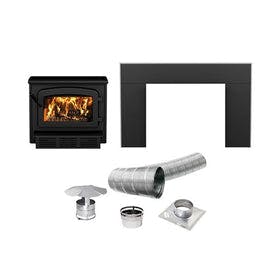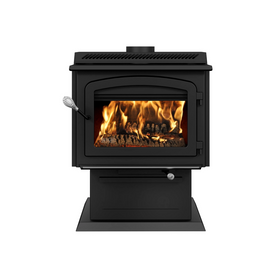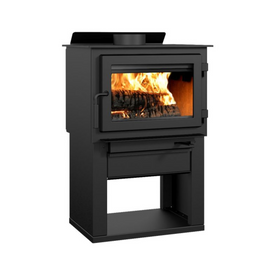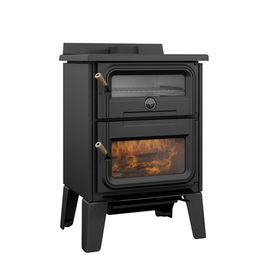
Wood, Gas, or Electric: How to Choose the Right Fireplace
Last Updated: Apr 11, 2025A fire is a fire. For most homeowners considering the luxury of installing a fireplace, a flame that produces heat is the only essential requisite when comparing the different models available to them. While some people might prefer the ease that comes with igniting a gas fireplace, others might enjoy the authenticity of burning firewood in the home. Unfortunately, most people don’t consider the actual heating capacity of the different fireplace models on the market today.
As winter is set to arrive, Rise takes a comprehensive look at the differences between gas, electric, and wood fireplaces. We offer some insight on essential design considerations to maximize the heating efficiency of the fireplace you choose and recommend some of the most efficient ones on the market today.
Table of Contents
- Does Heating Contribute to Global Warming?
- Comparing Gas, Electric, and Wood Fireplaces
- What Are The Pros and Cons of Gas Fireplaces
- What Are The Pros and Cons of Wood Fireplaces?
- What Are The Pros and Cons of Electric Fireplaces?
- The Best Designs for Wood Fireplaces
- Our Favorite Fireplace Manufacturers on the Market Today
Does Heating Contribute to Global Warming?
In 1997, earth collectively produced around 130 quadrillions Btu of energy from oil, 80 quadrillions Btu from coal, and 70 quadrillions Btu from natural gas. That’s a lot of fossil fuel energy. In the United States, despite the increase in renewable energy technologies, we still get 81 percent of our electricity from fossil fuel sources. Of course, the problem is that fossil fuels are a non-renewable resource, and the burning of these fuels is a significant contributor to global warming.
As these fuel sources become ever scarcer, prices will most likely continue to increase. Even the big Petro corporations estimate that we only have half a century of oil left. As countries worldwide struggle to meet their environmental responsibilities and obligations to reduce their carbon footprint, taxes on fossil fuel-based energy should only increase the overall price. In this scenario, depending on the local utility company to provide heat for your home could end up costing you thousands (instead of hundreds) of dollars each year.
A fireplace is an essential element of a resilient and sustainable home. It reduces your dependence on utility companies' energy and heating, and it can save you money on your heating bill. A well-designed fireplace can give you a renewable energy source that is actually carbon neutral. In the case of wood-burning stoves, the wood that you burn comes from trees that captured and stored carbon for dozens of years before being cut down. More efficient wood-burning fireplaces produce such a small amount of emissions that they can qualify as a smokeless heat source. We will review some of these.
Comparing Gas, Electric, and Wood Fireplaces
When choosing a fireplace for your home, you will have to select between gas, electric, and wood-fired options. There are pros and cons, but we believe that wood fireplaces offer more sustainability advantages.
What Are The Pros and Cons of Gas Fireplaces
The main advantage of gas fireplaces is the ease of use. Most of us live fast-paced lifestyles, and the idea of spending several hours chopping firewood is not very appealing to many people. On the other hand, gas fireplaces can be turned on with a simple switch or remote controls. Since gas fireplaces are used to space-heat certain areas of your home, consider turning down your central heating unit when utilizing the gas fireplace to heat the room.
On the downside, installing gas fireplaces can be expensive, and they sometimes may need a chimney or flue. Of course, gas fireplaces still rely on fossil fuels for combustion (usually either propane or natural gas), which will only add to the carbon footprint of your home.
What Are The Pros and Cons of Wood Fireplaces?
If you are looking for authenticity, wood fireplaces are the way to go. A quality wood fireplace offers much more than just a sustainable, renewable source of heat for your home. The ambiance created by a crackling fire and the sweet smell of hickory firewood is second to none, and your wood-burning fireplace can also offer a source of light and a cooking alternative if the power goes out. As we mentioned above, wood is also a carbon-neutral source of energy.
The main drawback of wood-burning fireplaces for homeowners is that you will have to source your own firewood. Most people won’t be chopping down their own trees, however, and the average price of a cord of firewood around the country comes to between $120 and $180. Another potential disadvantage of wood fireplaces is that wood fireplaces can be terribly inefficient when they are badly designed, sending up most of the heat out of the chimney. Incorrect installation of the fireplace damper can lead to cold drafts making their way into your home, thus increasing your house's overall heating requirements. In most cases, a fireplace insert offers a more efficient, easy-to-install option for homes that don’t have a functional fireplace.
What Are The Pros and Cons of Electric Fireplaces?
Electric fireplaces are another option on the market. Some people might debate whether these devices are fireplaces. However, the ability to plug in a device that will mimic a real fire in any room of your home is undoubtedly an excellent convenience. The electric fireplace's main downside is that these are glorified portable space heaters and are considered an inefficient way of producing heat for your home.
The Best Designs for Wood Fireplaces
For homeowners who decide that a wood-burning fireplace is the best option to heat their house sustainably, you will want to avoid the traditional masonry fireplace. Though beautiful, it usually sends about 80 percent of the heat it produces out the chimney. Newer fireplace models have incorporated several efficiency technologies that wood-burning stoves have incorporated over the years. These technologies include ceramic glass doors, high-efficiency firebox insulation, catalytic converters, and internal baffling. Some fireplaces also include adjustable combustion air supply so that the homeowner can control the overall output of heat into their home.
Fireplace inserts are another option for an efficient source of wood-fired heat for your home. These products include an airtight door system, which causes the fire to burn slower and thus reduce the amount of heat loss. In many cases, fireplace inserts can achieve an impressive efficiency rating of 80 percent. Also, inserts can usually be self-installed, helping to reduce the overall cost.
Our Favorite Fireplace Manufacturers on the Market Today

Chimney Specialists
This Wisconsin-based company offers several models of fireplace inserts, including wood-burning, gas, and electric and wood pellet models. If your home has an old, inefficient wood fireplace that has fallen out of use, Chimney Specialists can design a fireplace insert. It will add as an efficient complementary source of heat for your home.

Kozy Heat Fireplaces
Kozy Heat is another national company specializing in different types of fireplaces for your home. The Z-42 Wood Burning Fireplace that they offer is EPA-certified and produces an impressive 60,000 BTUs of heat per hour at 77 percent efficiency. This wood-burning fireplace can burn up to 22-inch logs, which will allow you to stoke your fireplace with large pieces of wood for overnight burning.
Tobias Roberts
Tobias runs an agroecology farm and a natural building collective in the mountains of El Salvador. He specializes in earthen construction methods and uses permaculture design methods to integrate structures into the sustainability of the landscape.











